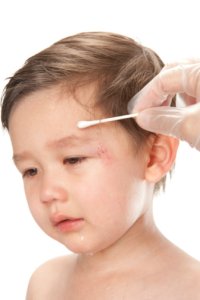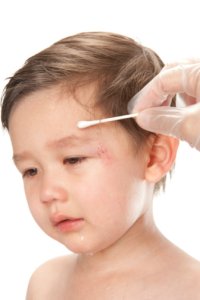Children are incredibly active and explorative. While playing, they can bang their head onto hard surfaces which puts them at risk for head injuries. It is important that parents know how to provide first aid for head injuries.
If you have a toddler or school-aged child, you might hear him complain about bumping his head onto the corner of the table or the wall or furniture. Although most of these head injuries are not serious, only resulting in a bruise or bump, severe or repeated head injuries can cause significant damage to the brain. Often it is difficult to tell whether the head trauma is serious or not. Providing proper first aid for head injuries can do a lot in improving the outcome of the child.
Usually, falls or blows to the head result in cuts to the scalp that can bleed out profusely. Bleeding in the face is more frightening than it is life-threatening – the face and head are very vascular and thus any cut can cause serious bleeding. On the other hand, internal brain injuries or intracranial bleeding is more serious and requires immediate emergency care.
So, what should you do if your child bumps his head?
If the child remains conscious, alert and behaves normally, first aid for head injuries includes applying cold compress over the injured area for 10 minutes. Continue observing the child for the next 24 hours.
Call 911 or your local emergency number; or drive your child to the nearest emergency department:
• If the child (especially for infants) loses consciousness, even for a brief moment; or if your child develops any of these symptoms following the injury:
• If the child develops signs and symptoms of brain injury that include:
• Complaints of head and neck pain
• Relentless crying
• Difficult to console
• Difficult walking normally or moving
• If the child develops signs and symptoms of brain injury that include:
o abnormal breathing
o unconsciousness
o suspected skull or neck fracture
o obvious serious wound
o bleeding or drainage of clear fluid from the ear, nose, or mouth
o disturbance of vision or speech
o unequal size of pupils
o dizziness
o irritability
o paralysis or weakness
o neck pain or stiffness
o seizure
o loss of bowel or bladder control
o vomiting (especially more than two or three times)
If the head injury occurred close to naptime or bedtime and the child sleeps soon afterward, be sure to check every now. Look for signs of twitching limbs or disturbances in breathing or color. There is no need to keep the child awake but monitor for unusual symptoms.
If you are not sure about your child’s appearance, arouse the child by sitting him up. Normally, the child must object to it and attempt to lie down. If the child does not respond, try to wake him up fully. However, if the child is difficult to rouse despite repeated attempts, call an ambulance right away.
First aid for head injuries is essential in preventing serious brain damage in children. In these emergencies, your goal is to alert emergency medical services or to bring your child to the nearest healthcare facility. Pediatric first aid courses usually include modules on how to manage head injuries in children. There are a number of training providers that offer first aid training courses across the country.

